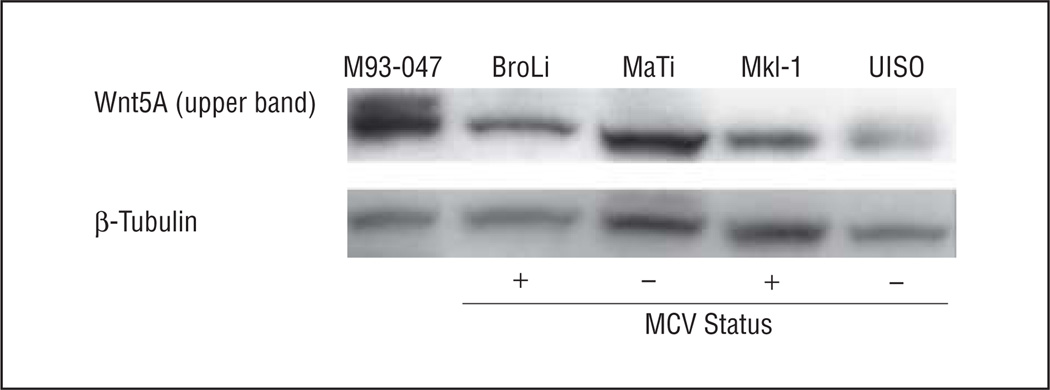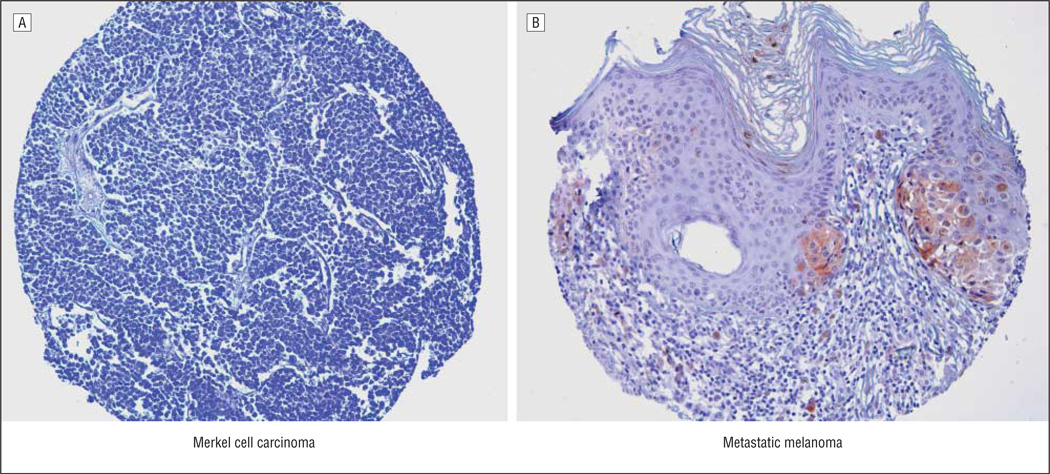Merkel cell cancer (MCC) is a rare skin cancer of neuroendocrine origin, the onset of which can be induced by chronic sun exposure.1 The molecular mechanisms underlying the development and progression of MCC are unclear. Recently, it has been shown that the Merkel cell polyomavirus (MCV) is causally linked to MCC. The DNA of MCV can be detected in approximately 80% of MCCs and has been demonstrated to be monoclonally integrated into the genome of the tumor cells that express the MCV large T antigen.2
The noncanonical Wnt signaling pathway is characterized by proteins such as Wnt5A, which is important in the progression of skin cancers such as melanoma.3 Wnt5A has also been shown to antagonize β-catenin signaling, 3 a member of the canonical Wnt signaling pathway. No mutations in key members of the canonical Wnt pathway (eg, CTNNB1 or APC) have been identified in MCC, and nuclear accumulation of β-catenin has been shown in a small percentage of MCC.4 The somewhat unusual lack of β-catenin activation in such an aggressive tumor, coupled with the fact that Wnt5A expression is high in other skin tumors, led us to hypothesize that perhaps Wnt5A is highly expressed in MCC and suppresses β-catenin.
Methods
We analyzed MCV-positive and MCV-negative MCC cell lines for Wnt5A expression. We used 2 well-established MCC lines, Mkl-1 (MCV+) and UISO (MCV−), and 2 additional cell lines (BroLi and MaTi), generated from patients in our clinic with MCC. BroLi has been shown by real-time polymerase chain reaction (PCR) to carry MCV DNA, while MaTi cells are virus negative. All cells were grown in RPMI 1640 medium (Sigma Chemical Co, St Louis, Missouri) supplemented with 10% fetal calf serum prior to lysis in radioimmunoprecipitation assay buffer. Western blot analysis for Wnt5A expression was performed as described previously.5
Results
Western analysis revealed no significant differences in Wnt5A expression among MCCs of differing metastatic or MCV status (Figure 1), and Wnt5A expression was very low in these cells. A metastatic melanoma cell line, M93-047, with a positive upper band for Wnt5A was used as a positive control. This upper band was absent in almost all MCC cell lines but registered faint positivity in the UISO cells.
Figure 1.
Western blot analysis of Wnt5A expression in Merkel cell cancer cell lines. The indicated cell lines were lysed in radioimmunoprecipitation assay buffer and subjected to Western blot analysis. Wnt5A (upper band) is present in the melanoma cell line M93-047, used as the positive control, and registers faintly positive in the UISO cell line. β-Tubulin was used as a loading control. MCV indicates Merkel cell polyomavirus. Plus signs and minus signs indicate positive and negative MCV status, respectively.
To confirm these findings, we also stained a tissue microarray of 32 primary and 17 metastatic MCC samples. Using real-time PCR analysis of tissue from tissue blocks that were subsequently cored to construct the tissue microarray, we found that MCV DNA was present in 44 of these tumors and absent in 5 (data not shown). Wnt5A staining was low or absent in virtually all samples analyzed (Figure 2A), and no difference between virus-positive and virus-negative samples was observed. Staining of a primary melanoma was used as a positive control for Wnt5A staining, where Wnt5A positive cells stained brown (Figure 2B).
Figure 2.
Immunohistochemical analysis of Wnt5A expression in Merkel cell cancer (MCC). A tissue microarray consisting of 32 primary and 17 metastatic MCC samples was stained with an anti-Wnt5A antibody. A, Consistent with the Western blot analysis, Wnt5A expression was absent in the vast majority of MCC. B, A malignant melanoma sample was used as a positive control for Wnt5A staining.
Comment
These data suggest that Wnt5A is not involved in the onset or progression of MCC and support other data that indicate that Wnt signaling is inactive in this cancer4 despite its neuroendocrine origins.
Acknowledgments
Funding/Support: This work was supported in part by funds from the Intramural Research Program of the NIA (O’Connell and Weeraratna) and from Wilhelm Sander- Stiftung grant 2007.057.1 (Drs Houben and Becker).
Footnotes
Author Contributions: Drs Weeraratna and Becker had full access to all the data in the study and take responsibility for the integrity of the data and the accuracy of the data analysis. Study concept and design: Weeraratna and Becker. Acquisition of data: Weeraratna, Houben, O’Connell, and Becker. Analysis and interpretation of data: Weeraratna, Houben, O’Connell, and Becker. Drafting of the manuscript: Weeraratna and Becker. Critical revision of the manuscript for important intellectual content: Weeraratna, Houben, O’Connell, and Becker. Administrative, technical, and material support: Weeraratna, Houben, O’Connell, and Becker. Study supervision: Weeraratna and Becker.
Financial Disclosure: None reported.
Role of the Sponsors: Wilhelm Sander-Stiftung had no role in the design or conduct of the study; in the collection, analysis, or interpretation of data; or in the preparation, review, or approval of the manuscript. The Intramural Research Program of the NIA had no role in the design or conduct of the study; in the collection, analysis, or interpretation of data; or the preparation of the manuscript; however, the manuscript passed through an internal NIA process that required review and approval.
References
- 1.Popp S, Waltering S, Herbst C, Moll I, Boukamp P. UV-B-type mutations and chromosomal imbalances indicate common pathways for the development of Merkel and skin squamous cell carcinomas. Int J Cancer. 2002;99(3):352–360. doi: 10.1002/ijc.10321. [DOI] [PubMed] [Google Scholar]
- 2.Becker JC, Houben R, Ugurel S, Trefzer U, Pfohler C, Schrama D. MC polyomavirus is frequently present in Merkel cell carcinoma of European patients. J Invest Dermatol. 2009;129(1):248–250. doi: 10.1038/jid.2008.198. [DOI] [PubMed] [Google Scholar]
- 3.Weeraratna ATA. Wnt-er wonderland–the complexity of Wnt signaling in melanoma. Cancer Metastasis Rev. 2005;24(2):237–250. doi: 10.1007/s10555-005-1574-z. [DOI] [PubMed] [Google Scholar]
- 4.Liu S, Daa T, Kashima K, Kondoh Y, Yokoyama S. The Wnt-signaling pathway is not implicated in tumorigenesis of Merkel cell carcinoma. J Cutan Pathol. 2007;34(1):22–26. doi: 10.1111/j.1600-0560.2006.00577.x. [DOI] [PubMed] [Google Scholar]
- 5.O’Connell MP, Fiori JL, Baugher KM, et al. Wnt5A activates the calpain-mediated cleavage of filamin A. J Invest Dermatol. 2009;129(7):1782–1789. doi: 10.1038/jid.2008.433. [DOI] [PMC free article] [PubMed] [Google Scholar]




